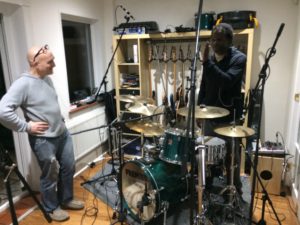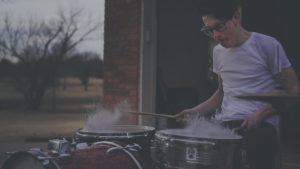
Recording drums is an art form all of its own. Producers often take days tuning, adjusting and miking up drum kits, to get the critical drum sound they want. Conversely, incorrectly placed microphones create phase problems that reduce the quality of the mix.
Over the decades, various tricks have emerged: to get a good sound using a very small number of microphones – or vast numbers; and legendary sessions where people have stomped on miked-up wooden stairs (the hook of “Bits and Pieces” by the Dave Clarke Five), or Foo Fighters’ recording the cymbals in a separate session to avoid their high frequencies interfering with the rest of the kit.

The article above provides cool examples of some methods of recording drums. My producer Jez Coad (in action in the photo at the head of this page), uses overheads and the usual microphone placements, but his USP is two condensers at least a couple of metres in front of the kit. These are placed with great care such that they take in the overall sound and character of the whole kit in the room – when it’s being played as in the session.
The critical part of the process is careful listening to each drum, and then the kit overall. Much adjustment accompanies this; gelling and taping to remove offending vibrations, and tuning. Jez uses as many mikes as he needs to get the sound he’s hearing in his head. For the session pictured above, 14 mikes were used, and the sound was awesome.
The so-called “Elbow Technique” is worth remembering, as a really simply but effective method. Using two small diaphragm condensers – I use two matched Octavias – you set up the kit complete with drummer on throne, then get him to stretch his elbows back and upwards as far as he can while holding his sticks as if about to play. Place one mike about a foot away from each elbow, pointing at the middle of the tom rack. Careful listening will suggest positional adjustments, and its worth also checking that each mike is the same distance from the toms. Adding a kick drum mike to this (if you have one), and an SM57 underneath the snare is optional, as this method can give you a really good drum sound with just the two condensers – hence its name.
Reddit users were asked for their top tips to recording drums, and this article lists some of their best – and most unusual – suggestions. 
Recording drums is so important, and so difficult and mythologised – and is often done badly, that I’ll add more techniques and links whenever I come across them. Rock On!!